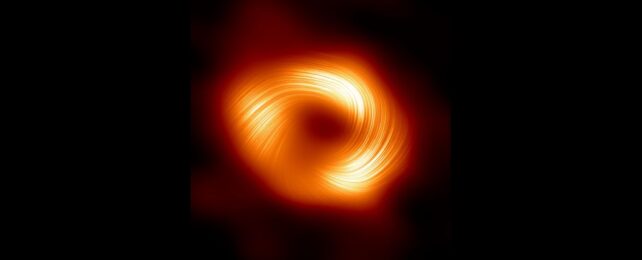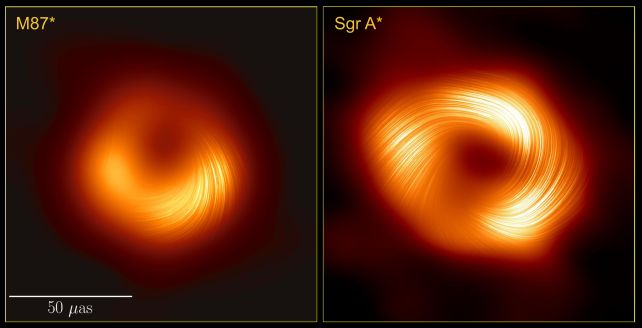ARTICLE AD
 The polarized light image that revealed the magnetic field of Sagittarius A*. (EHT Collaboration)
The polarized light image that revealed the magnetic field of Sagittarius A*. (EHT Collaboration)
The magnetic fields that spiral around our galaxy's supermassive black hole Sagittarius A* have now been revealed by twisted light.
A team of scientists has detected and measured the effect of polarization in a spectacular direct image of the shadow of Sgr A*. And, interestingly, it reveals a magnetic field structure similar to the only other supermassive black hole shadow ever directly imaged – M87*.
"What we're seeing now is that there are strong, twisted, and organized magnetic fields near the black hole at the center of the Milky Way galaxy," says astrophysicist Sara Issaoun of the Harvard & Smithsonian Center for Astrophysics.
"Along with Sgr A* having a strikingly similar polarization structure to that seen in the much larger and more powerful M87* black hole, we've learned that strong and ordered magnetic fields are critical to how black holes interact with the gas and matter around them."
Taking photos of black holes is not a trivial affair, and the Event Horizon Telescope (EHT) collaboration has been working for years to collect the data to process into images of Sgr A* and M87*.
But the effort doesn't stop there: The next step is to interpret the data to figure out how supermassive black holes work.
frameborder="0″ allow="accelerometer; autoplay; clipboard-write; encrypted-media; gyroscope; picture-in-picture; web-share" referrerpolicy="strict-origin-when-cross-origin" allowfullscreen>
One way to do this is to look at the way the oscillations of light are orientated, or polarized, by the black hole's environment. Electrons that are accelerated along powerful magnetic field lines emit light known as synchrotron radiation. Reading the polarization of this light spectrum reveals the strength and orientation of magnetic field lines.
"By imaging polarized light from hot glowing gas near black holes, we are directly inferring the structure and strength of the magnetic fields that thread the flow of gas and matter that the black hole feeds on and ejects," says astrophysicist Angelo Ricarte of the Harvard & Smithsonian Center for Astrophysics.
"Polarized light teaches us a lot more about the astrophysics, the properties of the gas, and mechanisms that take place as a black hole feeds."
The work to detect the magnetic field of Sgr A* was bipartite. The first step was to detect the polarization of the light observed using eight different telescopes, including the powerful Atacama Large Millimeter/submillimeter Array – one of the observatories around the world used to produce the initial image the black hole.
Once the signal was teased out of the data, the scientists needed to work out what it meant – map the magnetic field itself.
The results reveal a powerful magnetic field that twists around Sgr A*, and through the cloud of glowing dust that encircles it. And that magnetic field was remarkably similar to the magnetic field around M87* – the first supermassive black hole shadow the world had ever seen.
 The magnetic fields of the two black holes, M87* (left) and Sgr A* (right) revealed by polarized light. (EHT Collaboration)
The magnetic fields of the two black holes, M87* (left) and Sgr A* (right) revealed by polarized light. (EHT Collaboration)This is interesting, because there are some pretty significant differences between the two. Sgr A* is about 4.3 million times the mass of the Sun, and not very active at all. M87* has a mass of around 6.5 billion Suns (give or take), and is very active indeed. It would not be surprising to see different dynamics in the space around them; but here we are, with unncanny similarity.
This suggests that the physics around black holes scales pretty well, which gives us a new tool to interpret their behavior going forward and suggests features to look for.
"With a sample of two black holes – with very different masses and very different host galaxies – it's important to determine what they agree and disagree on," says physicist Mariafelicia De Laurentis of the University of Naples Federico II in Italy.
"Since both are pointing us toward strong magnetic fields, it suggests that this may be a universal and perhaps fundamental feature of these kinds of systems. One of the similarities between these two black holes might be a jet, but while we've imaged a very obvious one in M87*, we've yet to find one in Sgr A*."
We're just going to have to keep looking.
The research has been published in two papers in The Astrophysical Journal Letters. They can be found here and here.

 9 months ago
55
9 months ago
55 

